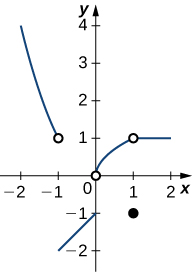2.R: Chapter 2 Review Exercises
- Page ID
- 50411
True or False. In exercises 1 - 4, justify your answer with a proof or a counterexample.
1) A function has to be continuous at \(x=a\) if the \(\displaystyle \lim_{x→a}f(x)\) exists.
2) You can use the quotient rule to evaluate \(\displaystyle \lim_{x→0}\frac{\sin x}{x}\).
- Answer
- False, since we cannot have \(\displaystyle \lim_{x→0}x=0\) in the denominator.
3) If there is a vertical asymptote at \(x=a\) for the function \(f(x)\), then \(f\) is undefined at the point \(x=a\).
4) If \(\displaystyle \lim_{x→a}f(x)\) does not exist, then \(f\) is undefined at the point \(x=a\).
- Answer
- False. A jump discontinuity is possible.
5) Using the graph, find each limit or explain why the limit does not exist.
a. \(\displaystyle \lim_{x→−1}f(x)\)
b. \(\displaystyle \lim_{x→1}f(x)\)
c. \(\displaystyle \lim_{x→0^+}f(x)\)
d. \(\displaystyle \lim_{x→2}f(x)\)

In exercises 6 - 15, evaluate the limit algebraically or explain why the limit does not exist.
6) \(\displaystyle \lim_{x→2}\frac{2x^2−3x−2}{x−2}\)
- Answer
- \(5\)
7) \(\displaystyle \lim_{x→0}3x^2−2x+4\)
8) \(\displaystyle \lim_{x→3}\frac{x^3−2x^2−1}{3x−2}\)
- Answer
- \(8/7\)
9) \(\displaystyle \lim_{x→π/2}\frac{\cot x}{\cos x}\)
10) \(\displaystyle \lim_{x→−5}\frac{x^2+25}{x+5}\)
- Answer
- DNE
11) \(\displaystyle \lim_{x→2}\frac{3x^2−2x−8}{x^2−4}\)
12) \(\displaystyle \lim_{x→1}\frac{x^2−1}{x^3−1}\)
- Answer
- \(2/3\)
13) \(\displaystyle \lim_{x→1}\frac{x^2−1}{\sqrt{x}−1}\)
14) \(\displaystyle \lim_{x→4}\frac{4−x}{\sqrt{x}−2}\)
- Answer
- \(−4\)
15) \(\displaystyle \lim_{x→4}\frac{1}{\sqrt{x}−2}\)
In exercises 16 - 17, use the squeeze theorem to prove the limit.
16) \(\displaystyle \lim_{x→0}x^2\cos(2πx)=0\)
- Answer
- Since \(−1≤\cos(2πx)≤1\), then \(−x^2≤x^2\cos(2πx)≤x^2\). Since \(\displaystyle \lim_{x→0}x^2=0=\lim_{x→0}−x^2\), it follows that \(\displaystyle \lim_{x→0}x^2\cos(2πx)=0\).
17) \(\displaystyle \lim_{x→0}x^3\sin\left(\frac{π}{x}\right)=0\)
18) Determine the domain such that the function \(f(x)=\sqrt{x−2}+xe^x\) is continuous over its domain.
- Answer
- \([2,∞]\)
In exercises 19 - 20, determine the value of \(c\) such that the function remains continuous. Draw your resulting function to ensure it is continuous.
19) \(f(x)=\begin{cases}x^2+1, & \text{if } x>c\\2^x, & \text{if } x≤c\end{cases}\)
20) \(f(x)=\begin{cases}\sqrt{x+1}, & \text{if } x>−1\\x^2+c, & \text{if } x≤−1\end{cases}\)
In exercises 21 - 22, use the precise definition of limit to prove the limit.
21) \(\displaystyle \lim_{x→1}\,(8x+16)=24\)
22) \(\displaystyle \lim_{x→0}x^3=0\)
- Answer
- \(δ=\sqrt[3]{ε}\)
23) A ball is thrown into the air and the vertical position is given by \(x(t)=−4.9t^2+25t+5\). Use the Intermediate Value Theorem to show that the ball must land on the ground sometime between 5 sec and 6 sec after the throw.
24) A particle moving along a line has a displacement according to the function \(x(t)=t^2−2t+4\), where \(x\) is measured in meters and \(t\) is measured in seconds. Find the average velocity over the time period \(t=[0,2]\).
- Answer
- \(0\) m/sec
25) From the previous exercises, estimate the instantaneous velocity at \(t=2\) by checking the average velocity within \(t=0.01\) sec.

